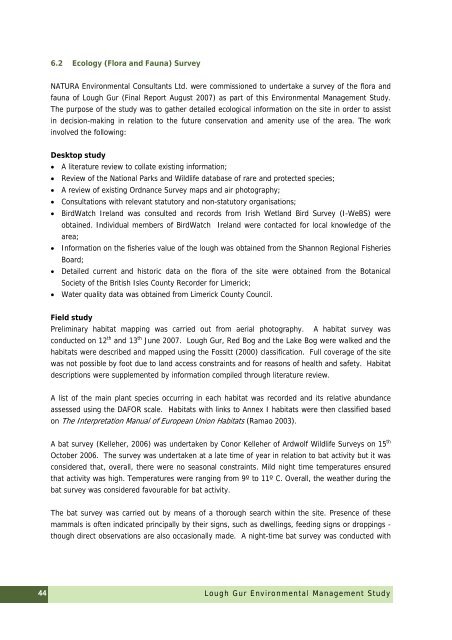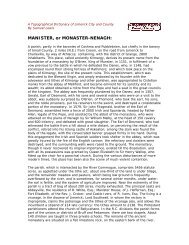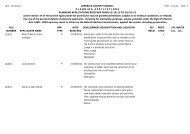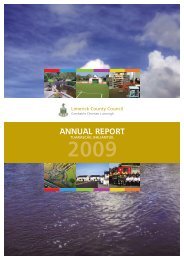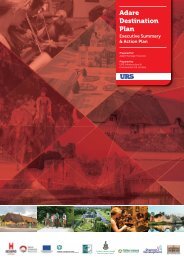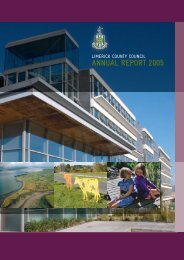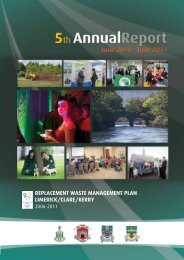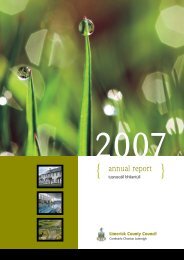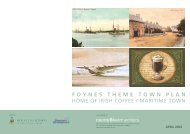Lough Gur Environmental Management Study February 2009
Lough Gur Environmental Management Study February 2009
Lough Gur Environmental Management Study February 2009
Create successful ePaper yourself
Turn your PDF publications into a flip-book with our unique Google optimized e-Paper software.
44<br />
6.2 Ecology (Flora and Fauna) Survey<br />
NATURA <strong>Environmental</strong> Consultants Ltd. were commissioned to undertake a survey of the flora and<br />
fauna of <strong>Lough</strong> <strong>Gur</strong> (Final Report August 2007) as part of this <strong>Environmental</strong> <strong>Management</strong> <strong>Study</strong>.<br />
The purpose of the study was to gather detailed ecological information on the site in order to assist<br />
in decision-making in relation to the future conservation and amenity use of the area. The work<br />
involved the following:<br />
Desktop study<br />
• A literature review to collate existing information;<br />
• Review of the National Parks and Wildlife database of rare and protected species;<br />
• A review of existing Ordnance Survey maps and air photography;<br />
• Consultations with relevant statutory and non-statutory organisations;<br />
• BirdWatch Ireland was consulted and records from Irish Wetland Bird Survey (I-WeBS) were<br />
obtained. Individual members of BirdWatch Ireland were contacted for local knowledge of the<br />
area;<br />
• Information on the fisheries value of the lough was obtained from the Shannon Regional Fisheries<br />
Board;<br />
• Detailed current and historic data on the flora of the site were obtained from the Botanical<br />
Society of the British Isles County Recorder for Limerick;<br />
• Water quality data was obtained from Limerick County Council.<br />
Field study<br />
Preliminary habitat mapping was carried out from aerial photography. A habitat survey was<br />
conducted on 12 th and 13 th June 2007. <strong>Lough</strong> <strong>Gur</strong>, Red Bog and the Lake Bog were walked and the<br />
habitats were described and mapped using the Fossitt (2000) classification. Full coverage of the site<br />
was not possible by foot due to land access constraints and for reasons of health and safety. Habitat<br />
descriptions were supplemented by information compiled through literature review.<br />
A list of the main plant species occurring in each habitat was recorded and its relative abundance<br />
assessed using the DAFOR scale. Habitats with links to Annex I habitats were then classified based<br />
on The Interpretation Manual of European Union Habitats (Ramao 2003).<br />
A bat survey (Kelleher, 2006) was undertaken by Conor Kelleher of Ardwolf Wildlife Surveys on 15 th<br />
October 2006. The survey was undertaken at a late time of year in relation to bat activity but it was<br />
considered that, overall, there were no seasonal constraints. Mild night time temperatures ensured<br />
that activity was high. Temperatures were ranging from 9º to 11º C. Overall, the weather during the<br />
bat survey was considered favourable for bat activity.<br />
The bat survey was carried out by means of a thorough search within the site. Presence of these<br />
mammals is often indicated principally by their signs, such as dwellings, feeding signs or droppings -<br />
though direct observations are also occasionally made. A night-time bat survey was conducted with<br />
<strong>Lough</strong> <strong>Gur</strong> <strong>Environmental</strong> <strong>Management</strong> <strong>Study</strong>


